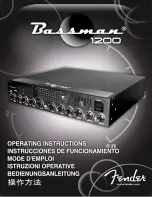
Probe
Adjustment
An
adjustable
capacitor compensates for slight
variations
in input capacitance from one in
strument
to another. This capacitor
is located
in the
probe body in the P510, P410, and
in
the
termination block at the instrument
end
of the cable in the P6017. It takes only
a
few seconds to check
this adjustment,
and it
is
a good practice to make this check each
time
the
probe
is
to be
used. Simply touch
the
probe to the oscilloscope calibrator-output
terminal and observe the calibrator waveform
on the screen. If necessary, adjust the
trimmer
for
a
flat top on the calibrator square wave.
To
adjust the Type P6000 probe, touch the
probe tip to the calibrator output connector
and
display several cycles of the calibrator
waveform.
If the top
and
bottom
of the dis
played
waveform is
not flat, loosen the locking
ring
by turning it in a counterclockwise
direc
tion.
Rotate the barrel of the
probe as neces
sary
to compensate the probe. Tighten the lock
ing
ring
carefully after compensating the probe,
being careful not to disturb the probe adjustment.
Input
Coupling
It
is sometimes
undesirable to
display the dc
level
of the waveform
being observed. Placing
the AC-DC
switch in the AC position
inserts
a
capacitor in series with the input so the
dc component of the
waveform is blocked
and
only
the ac
component is
displayed. The
low-frequency response is about 2 cps when ac
coupling
is
used.
Output Polarity
It
will be desirable to invert the displayed
waveform at
times, particularly when using
the
dual-trace feature of the Type
CA. The
POLARITY switch has two positions. In the
NORMAL
position the displayed waveform
will
have the
same
polarity as the input
signal.
In
the
INVERTED position the displayed wave
form
will
be turned upside down; that is,
a
positive-going
pulse
will
be displayed as
a
negative
going pulse.
DC
Balance Adjustment
After
the
plug-in unit has been in use for
a
period
of time you will notice
that the
trace
will
change
position
as the
VARIABLE
control
is
rotated. This
is caused by tube aging and
the
resultant shift in
operating
potentials. To
correct
this condition see Calibration
Section.
Gain Adjustment
Aging
of the
tubes will
also
affect the gain
of
the plug-in unit.
See Calibration Section
for
this
adjustment.
Positioning Adjustment
The Vert Pos
Range control balances the dc
output
level so the full
range
of the front
panel positioning controls can be
utilized. See
Calibration Section for this adjustment.
Types
of Operation
Generally
,
three types of operation
will
be per
formed using the
Type CA
Unit;
ALTERNATE,
CHOPPED,
and ADDED ALGEBRAICALLY. The
three
types
of operation are fundamentally
different so we will examine them in the order
stated.
ALTERNATE
Connect the two signals to be compared to
the
two signal inputs and turn the MODE switch
to
A
ONLY. Set the sweep up for triggered
operation
and adjust the VOLTS/CM and VER
TICAL
POSITION controls as necessary to
display the
waveform. Turn the MODE switch to
B
ONLY
and adjust the corresponding controls
as
necessary to display the other
waveform.
Now
turn the
MODE
switch to ALTERNATE.
If necessary, touch up the oscilloscope's sweep
triggering
controls to obtain a stable image.
Both
waveforms will now be displayed on the
crt
screen. As the
control
of each
amplifier
is independent you can position, attenuate, or
invert
the signals
as necessary
to compare
their shape,
relative amplitudes, etc.
Use the AC LF REJECT triggering mode
and
ALTERNATE
sweeps
for INTernal trig
gering
on signals having components above
10 kc. For
lower-frequency signals, use the
AC
triggering mode. In the AC
LF
REJECT
position, an
rc filter is inserted into the cir
cuit
allowing it
to
recover quickly from the
dc
level
changes
encountered with the ALTER
NATE
sweep. To compare the phase difference
between
two
signals, you should trigger
externally
using the
reference signals as the
trigger
signal.
2-2
Operating
Instructions - Type CA
AA
Содержание TYPE CA
Страница 3: ...Type CA http manoman sqhill com...
Страница 35: ...R4311E TYPE CA A VOLTS CM B BOTTOM VIEW...









































